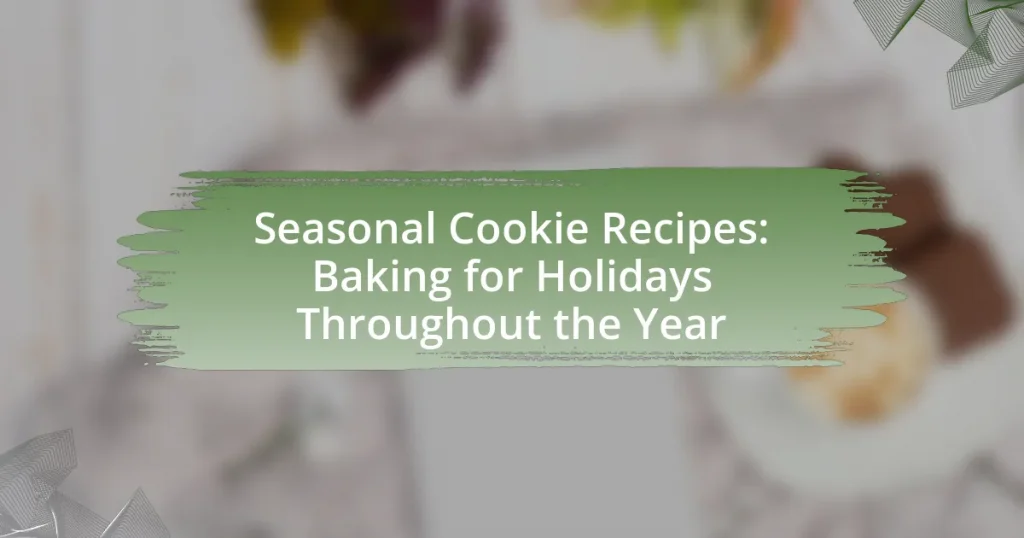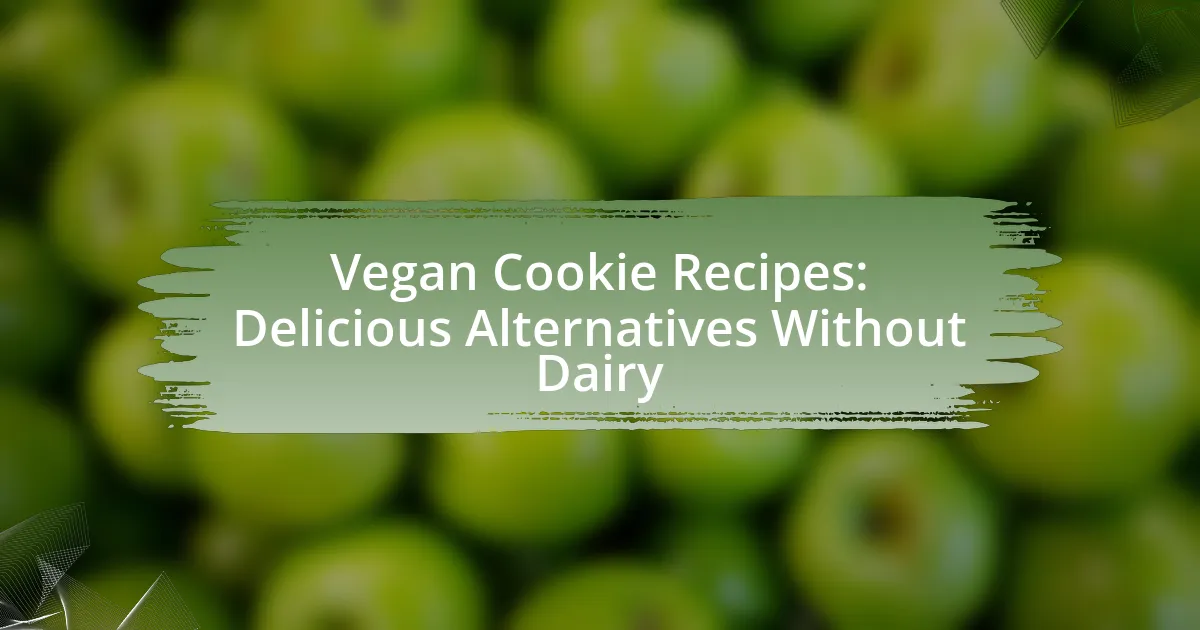Seasonal cookie recipes are specialized baking traditions that reflect specific holidays and seasons, incorporating ingredients and flavors that resonate with cultural celebrations throughout the year. This article explores the variations in cookie recipes across different seasons, highlighting popular ingredients and flavors associated with each holiday, such as gingerbread for Christmas and pumpkin spice for fall. It also discusses the significance of baking cookies during festive times, the traditions surrounding cookie preparation, and tips for successfully creating seasonal treats. Additionally, the article provides insights into customizing recipes for dietary needs and creative presentation ideas for gifting cookies.
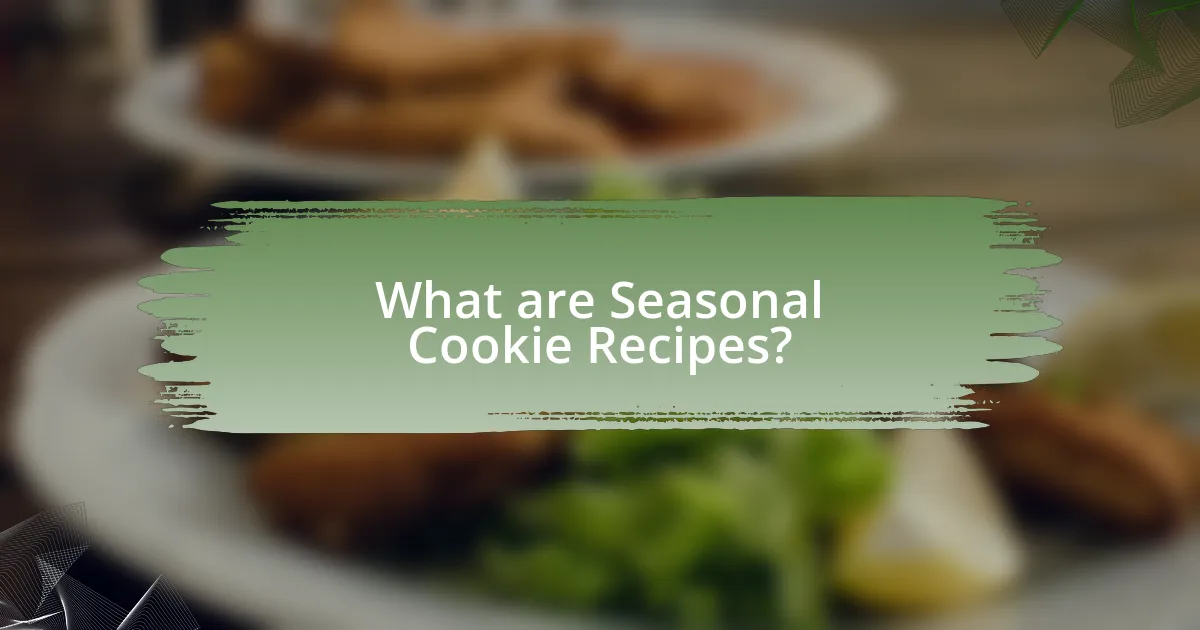
What are Seasonal Cookie Recipes?
Seasonal cookie recipes are specific types of cookie recipes that are traditionally prepared during particular holidays or seasons throughout the year. These recipes often incorporate seasonal ingredients, flavors, and themes that reflect the time of year, such as gingerbread cookies for Christmas, pumpkin spice cookies for fall, or sugar cookies decorated for Easter. The use of these seasonal elements not only enhances the taste but also aligns with cultural and festive celebrations, making them a popular choice for gatherings and festivities.
How do seasonal cookie recipes vary throughout the year?
Seasonal cookie recipes vary throughout the year by incorporating ingredients and flavors that reflect the specific holidays and seasons. For example, winter holiday cookies often feature spices like cinnamon and nutmeg, along with ingredients such as peppermint and chocolate, as seen in recipes for gingerbread and peppermint bark cookies. In spring, recipes may include fresh fruits like lemon and berries, aligning with the season’s themes of renewal and freshness, as evidenced by lemon sugar cookies or berry shortbread. Summer cookie recipes frequently utilize tropical flavors and lighter ingredients, such as coconut and lime, exemplified by coconut macaroons. In autumn, flavors shift to include pumpkin and apple, with recipes like pumpkin spice cookies becoming popular. This variation is influenced by cultural traditions and seasonal availability of ingredients, ensuring that cookie recipes remain relevant and appealing throughout the year.
What ingredients are commonly used in seasonal cookie recipes?
Common ingredients in seasonal cookie recipes include flour, sugar, butter, eggs, baking powder, and various flavorings such as vanilla, cinnamon, nutmeg, and ginger. These ingredients form the base of many cookie recipes, providing structure and sweetness. Seasonal variations often incorporate specific additions like pumpkin puree for fall cookies, peppermint extract for winter treats, or citrus zest for springtime recipes, enhancing the flavors associated with each holiday.
How do flavors change with the seasons in cookie recipes?
Flavors in cookie recipes change with the seasons primarily due to the availability of seasonal ingredients and traditional flavor profiles associated with specific times of the year. For instance, in spring, cookies often incorporate fresh fruits like strawberries and citrus flavors, while summer recipes may feature lighter ingredients such as coconut and tropical fruits. In autumn, spices like cinnamon, nutmeg, and pumpkin are prevalent, reflecting the harvest season, and winter recipes typically include rich flavors like chocolate, peppermint, and warm spices, aligning with holiday celebrations. This seasonal variation is supported by culinary traditions and consumer preferences that evolve throughout the year, influencing the types of flavors that are popular and sought after in cookie baking.
Why are seasonal cookie recipes popular during holidays?
Seasonal cookie recipes are popular during holidays because they evoke nostalgia and create a sense of tradition. These recipes often incorporate specific flavors and ingredients associated with particular holidays, such as gingerbread for Christmas or pumpkin spice for Thanksgiving, which enhances the festive atmosphere. Additionally, baking cookies during holidays serves as a communal activity, fostering connections among family and friends. This practice is supported by studies indicating that shared culinary experiences strengthen social bonds and create lasting memories.
What traditions are associated with holiday cookie baking?
Holiday cookie baking traditions include family gatherings, where members come together to bake and decorate cookies, often using recipes passed down through generations. This practice fosters bonding and creates lasting memories, as families typically engage in cookie exchanges and share their baked goods with neighbors and friends. Additionally, many cultures have specific cookie recipes tied to their holiday celebrations, such as gingerbread cookies for Christmas or mooncakes for the Mid-Autumn Festival, highlighting the cultural significance of these baked treats during festive times.
How do seasonal cookies enhance holiday celebrations?
Seasonal cookies enhance holiday celebrations by creating a festive atmosphere and fostering traditions. These cookies often feature unique flavors and shapes that are specific to particular holidays, such as gingerbread for Christmas or pumpkin spice for Thanksgiving, which evoke seasonal nostalgia. The act of baking and sharing these cookies strengthens social bonds among family and friends, as evidenced by studies showing that shared culinary experiences can enhance relationships and create lasting memories. Additionally, seasonal cookies often serve as decorative elements during celebrations, contributing to the overall aesthetic and enjoyment of the holiday festivities.
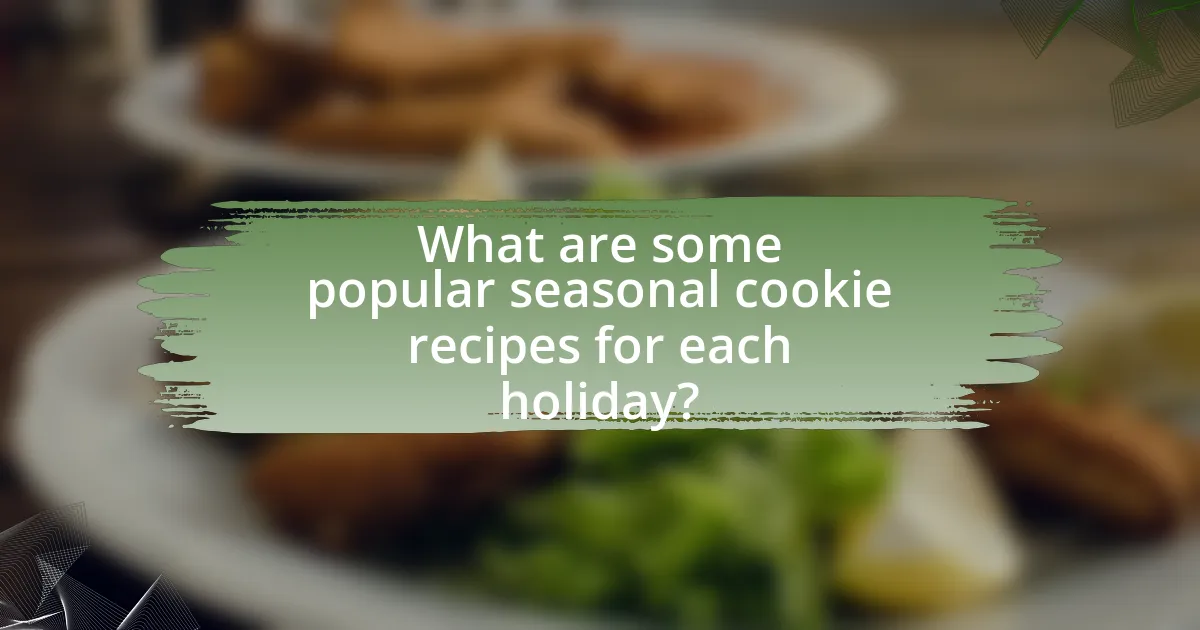
What are some popular seasonal cookie recipes for each holiday?
Popular seasonal cookie recipes vary by holiday, with specific favorites for each occasion. For Christmas, sugar cookies decorated with icing and gingerbread cookies are widely enjoyed. Valentine’s Day features heart-shaped cookies, often made with almond or vanilla flavors, and decorated with pink and red icing. Easter is celebrated with bunny-shaped sugar cookies and coconut macaroons. Halloween is marked by pumpkin spice cookies and spooky-themed sugar cookies. Thanksgiving often includes pecan pie cookies and cranberry orange cookies. Each of these recipes reflects traditional flavors and shapes associated with the respective holiday, making them popular choices for seasonal baking.
What cookies are typically baked for winter holidays?
Gingerbread cookies are typically baked for winter holidays. These cookies are often shaped into festive figures such as gingerbread men and houses, and they are flavored with spices like ginger, cinnamon, and nutmeg. The tradition of baking gingerbread dates back to the Middle Ages in Europe, where it became popular during the Christmas season. Other common winter holiday cookies include sugar cookies, which are often decorated with icing and sprinkles, and snickerdoodles, known for their cinnamon-sugar coating. These cookies are widely enjoyed and have become staples in holiday baking across various cultures.
How do gingerbread cookies differ from sugar cookies during winter?
Gingerbread cookies differ from sugar cookies during winter primarily in flavor and texture. Gingerbread cookies are spiced with ginger, cinnamon, and molasses, giving them a rich, warm flavor that is associated with winter festivities. In contrast, sugar cookies are typically sweeter and have a more neutral flavor profile, often enhanced with vanilla. The texture of gingerbread cookies is usually denser and chewier, while sugar cookies are softer and more cake-like. These differences make gingerbread cookies a traditional choice for holiday decorations and themes, while sugar cookies are often used for simpler, festive shapes and designs.
What unique decorations are used for winter holiday cookies?
Unique decorations for winter holiday cookies include royal icing, edible glitter, and fondant shapes. Royal icing is often used to create intricate designs and patterns, allowing for detailed decorations that can resemble snowflakes or holiday motifs. Edible glitter adds a festive sparkle, enhancing the visual appeal of cookies. Fondant shapes, such as stars, trees, and snowmen, can be molded and placed on cookies to create three-dimensional decorations. These elements are commonly utilized in holiday baking to create visually stunning and thematic treats.
What are the best cookie recipes for spring celebrations?
The best cookie recipes for spring celebrations include lemon sugar cookies, lavender shortbread cookies, and carrot cake cookies. Lemon sugar cookies are light and refreshing, perfect for spring, as they incorporate fresh lemon zest and juice, providing a bright flavor. Lavender shortbread cookies offer a unique floral taste, made with culinary lavender, which is often associated with springtime. Carrot cake cookies, inspired by the classic dessert, combine grated carrots, spices, and cream cheese frosting, making them a delightful treat for spring gatherings. These recipes are popular due to their seasonal ingredients and flavors that resonate with the freshness of spring.
How do floral flavors influence spring cookie recipes?
Floral flavors significantly enhance spring cookie recipes by introducing fresh, vibrant tastes that evoke the essence of the season. Ingredients such as lavender, rose, and elderflower add unique aromatic profiles, making cookies more appealing and reflective of spring’s renewal. For instance, lavender cookies not only provide a subtle sweetness but also a calming aroma, which aligns with the seasonal theme of growth and rejuvenation. The use of floral flavors in baking has historical roots, with cultures around the world incorporating flowers into culinary practices, thus validating their role in enhancing flavor and experience in springtime treats.
What are some popular Easter cookie designs?
Popular Easter cookie designs include decorated egg-shaped cookies, bunny-shaped cookies, and flower-shaped cookies. These designs are often adorned with vibrant icing, sprinkles, and edible glitter to reflect the festive spirit of Easter. The egg-shaped cookies symbolize new life and rebirth, while bunny cookies represent the Easter Bunny, a popular figure in Easter celebrations. Flower-shaped cookies celebrate the arrival of spring, making them a fitting choice for the holiday. These designs are widely recognized and frequently featured in Easter baking traditions.
Which cookies are favored during summer festivities?
Sugar cookies are favored during summer festivities. These cookies are often decorated with vibrant icing and can be shaped into various summer-themed designs, such as stars, suns, and flowers. Their light texture and sweet flavor make them a popular choice for events like barbecues, picnics, and family gatherings, where they can be easily enjoyed outdoors. Additionally, recipes for sugar cookies can be adapted to include seasonal flavors like lemon or coconut, enhancing their appeal during the warmer months.
How do seasonal fruits play a role in summer cookie recipes?
Seasonal fruits enhance summer cookie recipes by adding freshness, flavor, and moisture. Ingredients like berries, peaches, and citrus not only provide natural sweetness but also contribute vibrant colors and nutritional benefits, making cookies more appealing and healthier. For instance, blueberries are rich in antioxidants and can elevate the taste profile of cookies, while peaches add juiciness that can improve texture. The use of these fruits aligns with seasonal availability, ensuring that recipes utilize ingredients at their peak flavor and freshness, which is crucial for optimal taste and quality in baking.
What are some refreshing cookie ideas for summer picnics?
Refreshing cookie ideas for summer picnics include lemon sugar cookies, coconut macaroons, and watermelon cookies. Lemon sugar cookies provide a zesty flavor that is light and invigorating, making them ideal for warm weather. Coconut macaroons offer a chewy texture and tropical taste, perfect for a summer theme. Watermelon cookies, made with a sugar cookie base and decorated to resemble watermelon slices, add a fun and visually appealing element to any picnic spread. These cookie options not only taste great but also complement the refreshing nature of summer gatherings.
What cookie recipes are associated with fall holidays?
Cookie recipes associated with fall holidays include pumpkin spice cookies, pecan pie cookies, and apple cider cookies. Pumpkin spice cookies are popular for their warm spices and are often made with pureed pumpkin, reflecting the flavors of Thanksgiving. Pecan pie cookies mimic the classic dessert with a buttery base and a sweet pecan filling, commonly enjoyed during the fall season. Apple cider cookies incorporate apple cider and spices, capturing the essence of autumn and are frequently baked for Halloween and Thanksgiving gatherings. These recipes are widely recognized and celebrated during fall festivities.
How do spices enhance fall-themed cookie recipes?
Spices enhance fall-themed cookie recipes by adding warmth, depth, and complexity to flavors. Common spices like cinnamon, nutmeg, and ginger evoke the essence of autumn, creating a comforting and nostalgic taste experience. For instance, cinnamon has been shown to increase sweetness perception, allowing for reduced sugar usage while maintaining flavor richness. Additionally, the aromatic compounds in spices can stimulate appetite and enhance the overall sensory experience of baked goods, making them more appealing during the fall season.
What are the most popular cookies for Halloween and Thanksgiving?
The most popular cookies for Halloween include pumpkin spice cookies, decorated sugar cookies shaped like ghosts and pumpkins, and chocolate chip cookies with Halloween-themed sprinkles. For Thanksgiving, the favorites are pecan pie cookies, cranberry orange cookies, and classic pumpkin cookies. These cookies are widely recognized and enjoyed during their respective holidays, often featured in seasonal baking traditions and recipes.
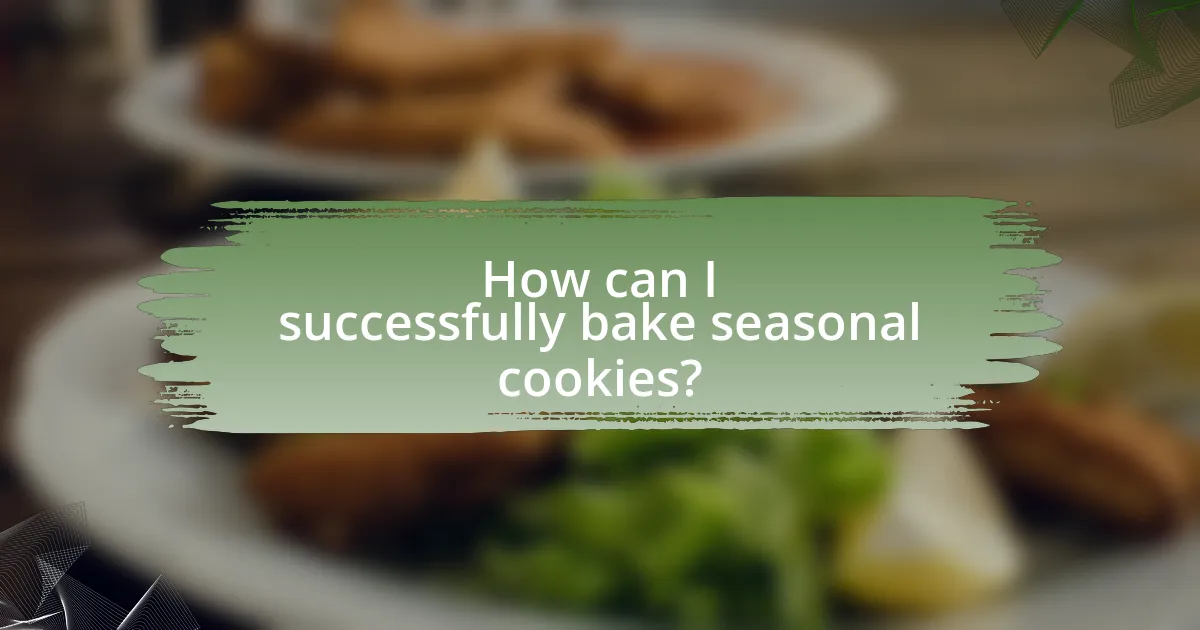
How can I successfully bake seasonal cookies?
To successfully bake seasonal cookies, follow a precise recipe that incorporates seasonal ingredients and flavors. For example, using pumpkin puree and spices for fall cookies or peppermint extract for winter treats enhances the seasonal experience. Accurate measurements and proper mixing techniques are crucial; overmixing can lead to tough cookies, while underbaking can result in a doughy texture. Additionally, preheating the oven to the correct temperature ensures even baking, as most cookie recipes require temperatures between 350°F and 375°F. Using parchment paper on baking sheets prevents sticking and promotes even browning. These practices are supported by baking science, which emphasizes the importance of ingredient ratios and baking conditions for optimal results.
What tips can improve my seasonal cookie baking skills?
To improve your seasonal cookie baking skills, focus on precise measurements and ingredient quality. Accurate measurements ensure consistent results, while high-quality ingredients enhance flavor and texture. For instance, using fresh spices and real vanilla extract can significantly elevate the taste of your cookies. Additionally, chilling dough before baking helps prevent spreading, resulting in a better shape and texture. According to the American Institute of Baking, proper dough handling techniques can improve the final product’s quality. Lastly, experimenting with seasonal flavors, such as pumpkin for fall or peppermint for winter, can make your cookies more festive and appealing.
How can I ensure my cookies have the right texture and flavor?
To ensure your cookies have the right texture and flavor, use precise measurements and quality ingredients. Accurate measurements of flour, sugar, and fat are crucial; for instance, using too much flour can lead to dry cookies, while too little can result in overly soft ones. Additionally, incorporating ingredients like brown sugar can enhance moisture and flavor due to its molasses content, while using butter instead of margarine contributes to a richer taste and better texture. Baking at the correct temperature, typically around 350°F, allows for even cooking, which is essential for achieving the desired texture. Finally, allowing cookies to cool on a wire rack helps maintain their structure and prevents sogginess.
What common mistakes should I avoid when baking seasonal cookies?
Common mistakes to avoid when baking seasonal cookies include not measuring ingredients accurately, which can lead to inconsistent texture and flavor. For example, using too much flour can result in dry cookies, while too little can make them overly soft. Additionally, neglecting to preheat the oven can cause uneven baking, affecting the final product. Another mistake is overcrowding the baking sheet, which prevents proper air circulation and can lead to cookies that are unevenly baked. Lastly, skipping the chilling step for dough that requires it can result in cookies that spread too much during baking, altering their intended shape and texture.
How can I customize seasonal cookie recipes for dietary needs?
To customize seasonal cookie recipes for dietary needs, substitute traditional ingredients with alternatives that meet specific dietary restrictions. For example, use almond flour or coconut flour instead of wheat flour for gluten-free options, and replace sugar with natural sweeteners like maple syrup or stevia for lower sugar content. Additionally, incorporate dairy-free substitutes such as coconut oil or almond milk in place of butter and milk for vegan recipes. These modifications allow for a variety of dietary preferences while maintaining the essence of seasonal flavors.
What substitutions can be made for gluten-free baking?
For gluten-free baking, common substitutions include almond flour, coconut flour, and gluten-free all-purpose flour. Almond flour provides a nutty flavor and moisture, while coconut flour is highly absorbent and requires additional liquid. Gluten-free all-purpose flour blends often contain a mix of rice flour, tapioca starch, and xanthan gum, which mimic the texture of wheat flour. These alternatives allow for successful gluten-free baking while maintaining flavor and texture in seasonal cookie recipes.
How can I adapt recipes for vegan cookie options?
To adapt recipes for vegan cookie options, replace eggs with flaxseed meal or applesauce, and substitute dairy butter with plant-based margarine or coconut oil. Flaxseed meal, mixed with water, creates a binding agent similar to eggs, while applesauce adds moisture and sweetness. Plant-based margarine or coconut oil provides the necessary fat content for texture. These substitutions maintain the cookie’s structure and flavor, ensuring a successful vegan version.
What are some creative ways to present seasonal cookies?
Creative ways to present seasonal cookies include using decorative cookie boxes, themed platters, and personalized gift bags. Decorative cookie boxes can be adorned with seasonal motifs, enhancing visual appeal and making them perfect for gifting. Themed platters, such as those shaped like Christmas trees or pumpkins, can create a festive atmosphere during holidays. Personalized gift bags, featuring the recipient’s name or a holiday greeting, add a special touch and make the presentation memorable. These methods not only elevate the aesthetic but also enhance the overall experience of enjoying seasonal cookies.
How can I package cookies as gifts for the holidays?
To package cookies as gifts for the holidays, use decorative boxes or tins that are food-safe and visually appealing. These containers not only protect the cookies but also enhance the presentation, making them suitable for gifting. Additionally, line the boxes with tissue paper or cellophane to cushion the cookies and prevent them from breaking. According to a survey by the National Confectioners Association, 70% of consumers prefer receiving homemade treats during the holidays, highlighting the importance of thoughtful packaging.
What are some fun decorating ideas for seasonal cookies?
Some fun decorating ideas for seasonal cookies include using royal icing to create intricate designs, employing edible glitter for a festive sparkle, and incorporating themed sprinkles that match the holiday. For example, during Christmas, cookies can be decorated with red and green icing to resemble ornaments, while Halloween cookies can feature orange and black colors with spooky shapes. These techniques not only enhance the visual appeal but also allow for creativity and personalization in cookie decorating, making them more enjoyable for both bakers and recipients.
